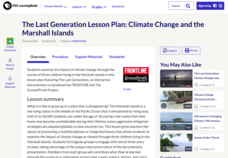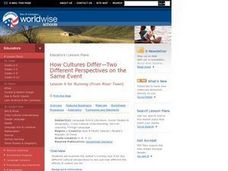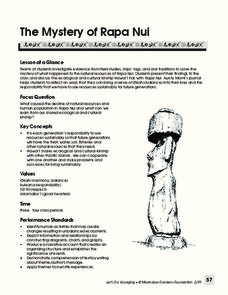Channel Islands Film
Island Rotation: Lesson Plan 3
How far have California's Channel islands moved? What was the rate of this movement? Class members first examine data that shows the age of the Hawaiian island chain and the average speed of the Pacific Plate. They then watch West of the...
PBS
The Last Generation: Climate Change and the Marshall Islands
Are some families down to their last generation? The final segment of a two-part climate change series investigates the vanishing Marshall Islands. Scholars divide into research teams to analyze three different individuals whose lives...
Society for Science & the Public
Easter Islanders Made Tools, Not War
When studying artifacts, especially tools, how do archaeologists determine what the devices were used for? In what ways might researchers' previous experiences influence their perception of an artifact? An article about researchers'...
Angel Island Immigration Station Foundation
Where Is Angel Island? An Introductory Geography Lesson
Prepare young historians for a study of Angel Island Immigration Station with a lesson examining primary and secondary source materials, maps, and websites. Using what they have learned, individuals create a map of Angel Island, labeling...
US House of Representatives
Exclusion and Empire, 1898–1941
Often forgotten and written off as the model minority, Americans with heritage in Asia and the Pacific Islands have played an essential role in American history, including Congress. Budding historians reclaim history by researching the...
Curated OER
Is there a map in that story?
Eighth graders examine different pieces of literature from specific isolated Pacific islands. In this Geography lesson, 8th graders read and interpret a written selection. Students construct a map of the stories setting.
Curated OER
Protecting Philippine Reefs
Students watch a slide show about the Philippine Reefs to explore the topic of fish populations. In this reef and fish population lesson, students watch a slide show about fish populations and how the Peace Corps works with Filipinos to...
Curated OER
Celebrating Asian and Pacific-Island Heritage
Young scholars complete a variety of activities surrounding Asian Pacific American Heritage Month in May.
Curated OER
Victory in the Pacific, 1943-1945
Students examine the military campaigns of the Pacific theater, tracing the path of the Allied offensives. The lesson presents what the Allies were trying to accomplish and why.
Channel Islands Film
Island Rotation: Lesson Plan 1
How do scientists provide evidence to support the theories they put forth? What clues do they put together to create these theories? After watching West of the West's documentary Island Rotation class members engage in a series of...
Curated OER
Turning the Tide in the Pacific, 1941-1943
Students analyze the Japanese strategy for the Pacific and compare it to the Allied strategy. They identify on a map the sites that were important the early war in the Pacific, and identify key military engagements.
Curated OER
Breaching the Gulf Between Cultures
Learners study the dynamics, the challenges, and the rewards of adjusting to a new culture, as illustrated by the author's account of his father's coming to terms with Sri Lankan customs. They reach the enduring understanding, "It is...
Curated OER
Encountering Very Different Ways of Life
Students explore the concept of crossing cultures. They examine how Americans may be viewed by people in another culture and discover that that Peace Corps Volunteers are trained to cross cultures respectfully so that they are accepted...
Curated OER
Confronting Two Challenges-One Physical, One Intellectual
Students examine how the author confronted the challenges of a new language and a new culture. They examine how the author's penchant for running featured in his adjustment to the culture of Fuling and in his learning of the Chinese...
Curated OER
How Cultures Differ-Two Different Perspectives on the Same Event
Students examine the author's running race from two different cultural perspectives to see just how different the effects of culture can be. They practice thinking about an issue from different perspectives and create a script that can...
Curated OER
Out With the Old, In With the New
Students study China's cultural and economic complexities through a slide show that is written, read, and photographed by a Peace Corps Volunteer. They answer the questions: What does SARS stand for? [Severe acute respiratory syndrome]...
Curated OER
Where in the World War? Mapping WWII in the Pacific
Students explore the Pacific Theatre of War. In this World War II lesson, students use reference material to access information about significant locations in the Pacific Theatre of War. Students identify the locations of the listed...
Curated OER
Easter Island
Fifth graders describe the location and physical environment of Easter Island. This description include: identification of the closet continent to Easter Island, ocean in which Easter Island is located, and some geographical features of...
Moanalua Gardens Foundation
The Mystery of Rapa Nui
What caused the collapse of the environment on Rapa Nui (Easter Island)? Who constructed the Moai? What was their purpose? Class members assume the role of investigators and use evidence drawn from field studies, ships' logs, and...
NOAA
The Biggest Plates on Earth
The deepest part of the ocean is the Marianas trench where two tectonic plates meet. Scholars explore plate tectonics and their boundary types by completing hands-on activities throughout the lesson. Specific areas, such as the Galapagos...
Curated OER
Breaching the Gulf Between Cultures
Students explore the dynamics, the challenges, and the rewards of adjusting to a new culture through the reading of "Help! My Father is Coming" and "The Visit to Vijay's". In this social culture activity, students carousel brainstorm...
Curated OER
Encountering Very Different Ways of Life
Young scholars explore the concept of crossing cultures through reading the stories "Help! My Father is Coming!" and "The Visit to Vijay's." In this culture lesson plan, students predict what will happen next in the stories. Young...
Curated OER
Confronting Two Challenges--One Physical, One Intellectual
Students examine the challenges of a new language and culture. In this cultural lesson, student read Running by Peter Hessler and discuss obstacles faced, including the language barrier. Students write an essay about a time they...
Curated OER
How Cultures Differ - Two Different Perspectives on the Same Even
Students explore the effects of culture through the story Running by Peter Hessler. In this geography and cultural lesson, students act as newspaper reporters covering the story of the race. Students write newspaper articles as reporters...
Other popular searches
- Asia & Pacific Islands
- South Pacific Islands
- Pacific Islands New Zealand
- Pacific Islands Art
- Pacific Islands Music
- Imperialism Pacific Islands
- Cultures Pacific Islands
- Mythology Pacific Islands
- Pacific Islands New Zeal And
- Pacific Islands Geography

























